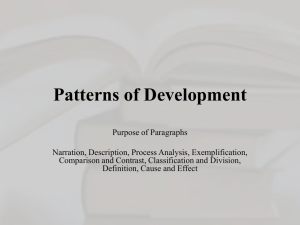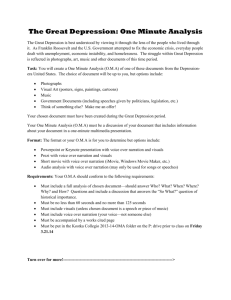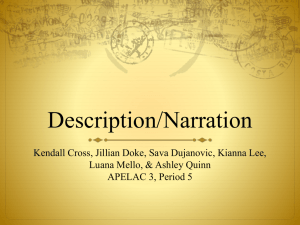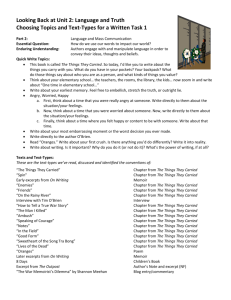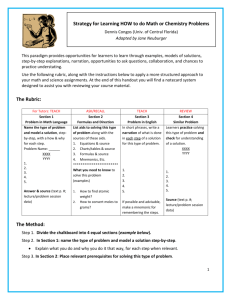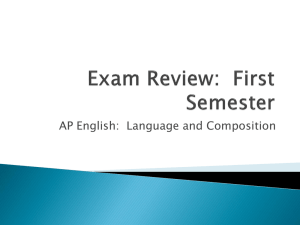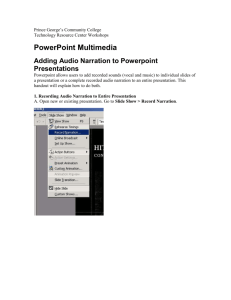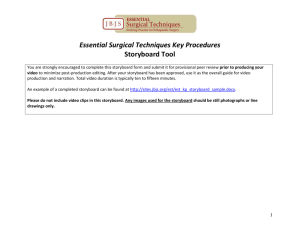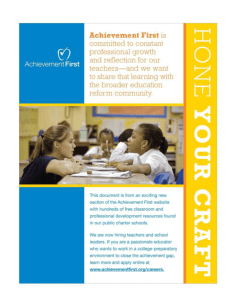DESQ-LoughboroughColSportContentReview
advertisement
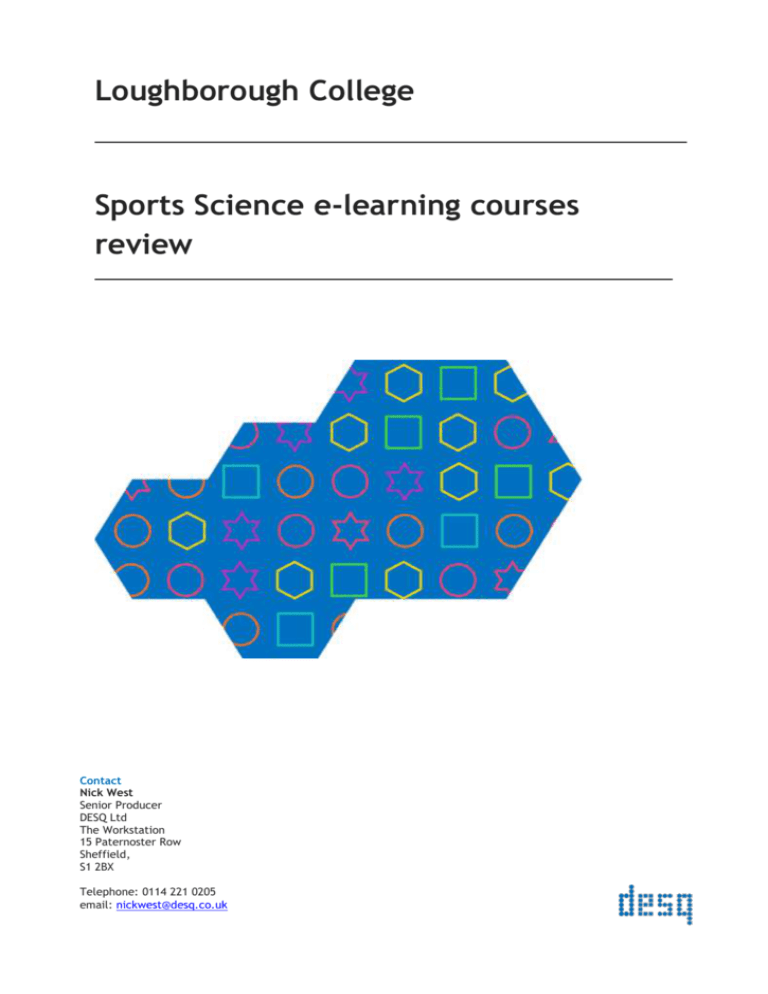
Loughborough College Sports Science e-learning courses review Contact Nick West Senior Producer DESQ Ltd The Workstation 15 Paternoster Row Sheffield, S1 2BX Telephone: 0114 221 0205 email: nickwest@desq.co.uk 1 Introduction DESQ have reviewed some of the sports department e-learning courses for the Foundation Degree Year 1 course and have written this report on how future developments could further improve learners’ e-learning experience. 2 Overview Overall, it is clear that the creators of these materials have put a lot of work in to make them engaging and interesting. There is good variety, with lots of images, interactions, diagrams, tables and videos. The use of different weights and colours of type works well in places too. 3 VLE The new design of the Learnzone VLE is attractive and modern-looking. It improves on the navigation of the previous version, making it easier to find content. Moving the College Links to their own section on the navigation bar has greatly improved the usability. Each section is clearly defined and delineated. The ‘Meet the new LearnZone’ news item is very useful – the two-part headline box above the Course Categories section looks great, and provides useful information. This could be built up over time to offer news, advice and guidance to students. 4 Online lectures 4.1 Narration All except for one of the online lectures reviewed featured a series of slides with linked narration. This works well to replicate the lecture theatre experience of a tutor talking through a PowerPoint presentation, however it this does raise some issues: If the courses are to be sold separately, the narration would benefit from being professionally recorded. In the main, the narration is very good, but there are some microphone pops and crackles, and some places where the narrator sounds unsure or mispronounces a word. Again, to allow the courses to be sold, the narration would have to be rewritten to avoid mentioning external resources or what has been learned in previous weeks. Any narration used should ideally stick exclusively to what is contained within the course. The narration can be problematic for learners with hearing difficulties, or those who do not have access to headphones or speakers. One way of getting round this would be to use the Notes functionality in Articulate to provide a transcript of the narrative, or perhaps to provide a Word version that can be downloaded from the documents section. 2 With this in mind, it may be worth looking at keeping narration to a minimum, and ensuring that all the relevant information is displayed on the screen. This would mitigate any issues with learners’ hearing or sound equipment. Useful areas for narration could include instructions for interactions or definitions of learning objectives. If narration is desired throughout all pages of the content, there are ways in which this could be more effectively employed to aid the learning process. Some of these ways are explored in the next section. 4.2 Audio and visual synergy During a slide, it would improve comprehension if text and graphics either appeared or were highlighted as the relevant voice over was spoken; for example, bullet points which appear one-by-one in time with the audio. Users may feel there is too much to take in when a slide first appears, and as a consequence they could end up reading ahead or trying to makes sense of the slide rather than listening to the audio. Some of the materials use this technique already and we would suggest it should be applied consistently wherever appropriate. Highlighting relevant areas of diagrams, charts and illustrations when they are being described in the voiceover will also be helpful. The example below shows a table that is described by accompanying audio. Highlighting areas in time with the audio will make it easier for users to absorb what is being said, rather than trying to locate the areas of the table that are being described. It is also helpful if the text is arranged on the slide in the order it is described in the voiceover. At the moment this is inconsistent. When text and audio start in sync but then go out of sync the user could think that have missed something. They may start to look around the slide for the content that is being voiced, causing them to lose the thread of what is being said. 3 4.3 Images If the materials were to be sold, it is likely that some of the images would have to be replaced. Although nearly all images are attributed, this would not be enough to use them for commercial purposes. Original artwork could be used in such a way that there is a lot of re-use (for instance, one image of a torso can be used many times with different labels). This would also ensure that a consistent quality could be attained throughout the courses; at present, some of the interactions are let down by poor images. For instance, Slide 11 of ‘Muscle anatomy’ is a really good interaction, but the image lets it down. Elsewhere, images are distorted, stretched or feature unreadable text. 4.4 Design Whilst much of the content features a nice, clean design, the following areas could be improved to increase the usability, user comprehension and user experience significantly. This will also give the resources a visual coherence that will make them feel like a suite of materials. Use a simple grid system The resources will feel more like part of a coherent set if some layout principles are followed consistently. For example, this means that repeated screen types such as the first screen and Aims screen should always use exactly the same layout. Below are four Aims screens from the ‘Functional Anatomy’ and ‘Fitness Training and Testing’ courses which would benefit from a consistent layout. The purpose of these screens is consistent, so they should look consistent. 4 5 There should also be a consistent use of margins, borders and text styles (headings, bullets, body text etc). Compare the two examples below of bullet points: 6 There are slides that feature different sizes of text (slide 14 of the ‘Cardiovascular system’ lesson features enormous text, whereas slide 6 of the ‘Endurance performance’ lesson has some text that is very small and difficult to read). There are different styles of text too – some slides (for instance slide 4 of the ‘Endurance performance’ lesson) have text that has been underlined for emphasis, but emphasised text should ideally be bold, with underline being saved for links. Using master templates and a simple style guide would help to mitigate these issues. These consistency principles may seem relatively minor, but without them the user experience will be one where the content doesn’t feel coherent and the user won’t trust it as much as they should. We aren’t saying everything should sit within a rigid and formulaic structure. Rather that there needs to be a consistent framework that gives ample room for varied and creatively presented content. 4.5 Content Overall, the content is engaging and relatively easy to understand, with the learning objectives well met and information provided in a logical and clear manner. However, there are areas where the text needs proofing and editing, due to inconsistencies with punctuation, spelling and tone. For example, on slide 7 of ‘The respiratory system’ the second and third sentences need full stops as well as little typos fixing, slide 14 of ‘Endurance performance’ – ‘to’ instead of ‘too’, slide 14 of Flexibility – ‘effect’ instead of ‘affect’. There are a couple of slides where a question is asked, suggesting that there’s a free text interaction on the screen, but there’s actually no interaction to complete. This can be seen on slides 10 and 11 of ‘Bones of the Vertebrae’. 7 There are quite a few places where the learner is asked to complete something and bring it to a following lesson or seminar (see slide 3 of ‘The upper limbs’ for an example). Although this will work in the context of learners doing the course with Loughborough College, it will make it more difficult to sell as a standalone package. Perhaps these could be given as extension activities at the end of the lesson with more generic instructions for handing them in? 4.6 Content per slide Some of the slides are over-populated. Users will find the information easier to digest if information is spread out over more slides or presented through interactive elements such as hotspots. The screens below show good and bad examples of this. This layout is well spaced and easy to digest 8 This layout is too cramped and difficult to digest Conversely, other slides have very little on them, but what is there has been made bigger to fit the screen – see Slide 18 of ‘Cardiovascular system’. A more consistent and templated approach would again help to address this issue. 9 4.7 Interactions Interactions should always have clear instructions telling the user how to interact, i.e. what to click on, if something is draggable etc. At the moment this isn’t always the case, so it’s left to users to work out how to interact. Some, more IT literate users will be able to do this, but there will be some who won’t. The example below would benefit from instructional text along the lines of “Click and drag the definitions on the right to the correct terms on the left. Make sure the two pieces join together”. Interactions are also more usable if they don't scroll. In the example above it would be easy to miss the interactive elements that are off screen. This could be addressed by splitting the interaction across two or more screens. Using buttons or hotspots which animate can distract the user from the content being presented. The current design of the buttons is good, and is enough of a clue that they are interactive. There isn’t a need for them to flash or pulse. Some of the interactions are difficult to successfully complete. A particular example of this can be found in slide 5 of ‘Bones of the Vertebrae’. The click areas are very small, and there’s nothing in the instructions to say that you have to click within the white space next to the image – it feels more logical and natural to click on the actual image itself. This meant that even though we identified the correct places on the spine, we failed the test with 0%. This is also a problem on slide 11 of ‘The neuromuscular system’. A consistent approach to interaction design, along with a user trialling policy would help to ensure that any interactions are clear, easy to use and capable of reinforcing the learning without frustrating the learner. 10 For some of the interactions the questions are poorly framed. For example, slide 13 of ‘Introduction to Functional Anatomy’ – instead of ‘Which of these is an example of a hinge joint?’, the question is ‘This is an example of a hinge joint’. If a quiz features a text entry question, it is imperative that there are a number of correct answers to ensure that it’s not frustrating for the learner. For instance, on slide 15 of ‘The respiratory system’, I failed a question for entering ‘They expand’, when the correct answer was ‘expand’ or ‘move up and out’. Also, one of the answers for question 3 of this quiz is ‘moves down and flatterns’, which is spelt incorrectly. For example, in the case where the answer is ‘expand’, it would be sensible to offer the following options as correct answers: They expand Expansion Expansion takes place Expand Move up and out They grow in size Video Whilst some of the YouTube videos are good and of high quality, there are some that are not so good. For instance, the video with the body builder in the ‘Flexibility’ lesson. Also, some seem to have little to do with the content, for instance the Diet Coke and Mentos video in the ‘Periodisation’ lesson. Also, there is a broken link to a video in ‘The neuromuscular junction’, slide 8. Commissioning professional and high quality video for the materials will help to mitigate this issue. Other Some of the slides are not named correctly in the Outline pane (for instance, slide 4 of Bones of the Vertebrae is just called Slide 4). This just needs amending in Articulate. Again, this will add to the overall quality and consistency of the materials. 5 Conclusion To conclude, there is a lot of really good, usable content within the lessons. To realise the potential of the learning materials, some relatively minor changes could be made to ensure consistency and a high standard of quality throughout. There also needs to be a content production process for people to follow and use as a guide. This will ensure quality procedures such as proofing and testing are followed. This would be a simple document to guide people through the process and offer links to templates, style guides, and so on, that they should be using. 11 6 Next steps The suggested next steps are: Create and distribute a suite of templates for PowerPoint and Articulate to all content developers. Create and distribute a set of guidance notes that offer best practice for layout, design, learning flow and use of media. Edit existing materials to ensure consistency in content, layout and voice. Create new images that can replace those within the materials and that can preferably be used across different modules. Explore the use of bespoke video to bring the materials to life. 12

